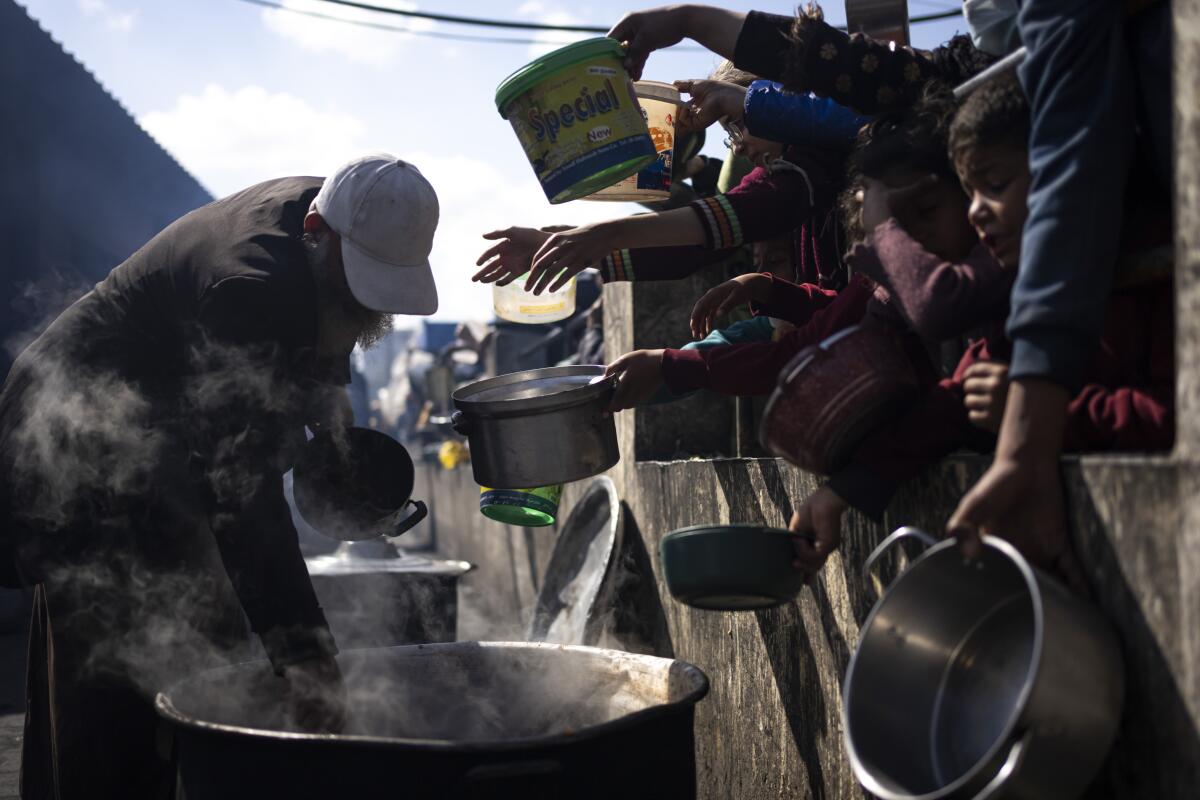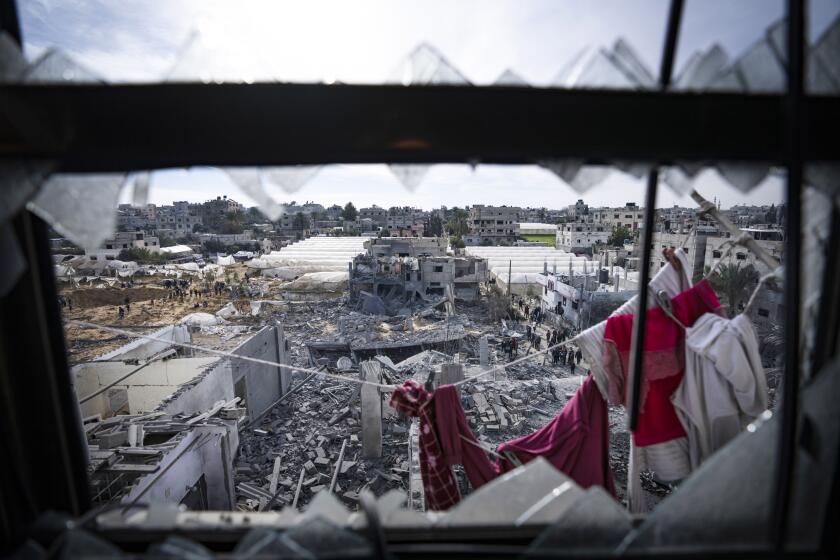How the U.S. military is scrambling to build a floating dock for urgently needed aid to Gaza

- Share via
WASHINGTON — Even before President Biden announced in his State of the Union address the plans for providing aid to Gaza by sea, the Army’s 7th Transportation Brigade and other units were scrambling to pull equipment together.
They received their orders before the speech: Build a floating dock off the Gaza coast to provide food and other desperately needed assistance to residents. The aid is needed because Israel has sharply restricted land routes into the Palestinian territory, slowing the flow of aid to a trickle.
It’s a complex operation, involving as many as 1,000 U.S. troops, and it won’t happen overnight. Air Force Maj. Gen. Pat Ryder, the Pentagon press secretary, told reporters it will take weeks for this to come together. Some officials say it will take about two months. And beyond the logistical challenges, the operation will depend on Israel’s cooperation, which isn’t assured.
Here’s a look at what’s known about the operation:
Why build a floating pier?
In the five months since Hamas militants attacked Israel on Oct. 7, killing about 1,200 people and taking 250 others hostage, Israel’s military has battered the territory, killing more than 30,000 Palestinians, according to the Health Ministry in Hamas-run Gaza. The result of the Israel-Hamas war is a devastating humanitarian catastrophe.
The U.N. says virtually all of Gaza’s 2.3 million people are struggling to find food, and more than a half-million currently face starvation. Many people have been reduced to eating animal fodder to survive.
‘The child deaths we feared are here.’ It’s not just Israeli bombs that have killed children in war-ravaged Gaza. Some are dying of starvation.
Getting in food, medical supplies and other aid has been difficult, if not impossible at times, due to the ongoing hostilities and struggles to coordinate with the Israeli military, which has blocked routes and slowed deliveries due to inspections.
Trucks carrying humanitarian aid have to drive from the Rafah crossing with Egypt or the Kerem Shalom crossing with Israel, both on the southern edge of Gaza, through the conflict zone to reach the largely cut-off areas in the north.
Gazans crammed into Rafah along the Egyptian border have no place to escape as Israeli attacks hit ever closer in a final bid to rescue remaining hostages.
It’s been frustrating for the Biden administration as its efforts to step up aid to Gaza have been impeded by the obstacles posed by Israel, its close ally.
Last week, the U.S. began airdrops of aid for Gaza. But that can provide only a limited amount of aid and may not reach those who need it.
Biden has directed the military to construct a temporary pier on Gaza’s coast “that can receive large ships carrying food, water, medicine and temporary shelters.”
Biden said in his State of the Union address that the pier will “enable a massive increase in the amount of humanitarian assistance getting into Gaza every day.”
With family trapped in Gaza, two Palestinian friends in the West Bank hold each other up amid crushing grief.
Assembled like LEGOs
According to defense officials, the 7th Transportation Brigade based at Joint Base Langley-Eustis in Virginia is already pulling together what’s called the Joint Logistics Over The Shore (JLOTS) equipment and watercraft.
It’s like a huge Lego system — an array of 40-foot-long pieces of steel that can be locked together to form a pier and causeway. The causeway would be up to 1,800 feet long and two lanes wide.
And in the coming days, U.S. troops will begin loading the equipment onto a large Military Sealift Command vessel. The equipment will include the steel pieces and smaller tug vessels that can help move things into place.
Then, the ship will set off across the Atlantic Ocean with members of the 7th Transportation Brigade aboard. A number of other military units from the U.S. and abroad will also take part in the mission.
Ryder said once the troops have built the offshore pier, large ships can offload food and supplies. Then smaller military vessels will transport that aid from the floating pier to the temporary causeway that will be driven into the ground at the shoreline.
Biden said Thursday that there will be no U.S. forces on the ground in Gaza for the mission, which will likely involve other allies, contractors and aid agencies.
What are the challenges?
A key question will be what Israel is prepared to do to support the aid delivery effort.
The U.S. airdrops have been an unusual workaround by the Biden administration, which for months has appealed to Israel to increase the delivery of aid to Gaza and provide access and protection for trucks carrying the goods.
According to Biden, the Israeli government will maintain security at the pier and protect it from any attacks by Hamas. And there may also be a need for crowd control, in case residents try to storm the pier to get the desperately needed food.
Though officials said they don’t likely need security on the sea route to Israel there will be a requirement for allies and private ships to deliver the aid along the maritime corridor.
It is also unclear who will be unloading the aid at the dock and moving it to shore.
What are other nations and groups doing?
Cypriot President Nikos Christodoulides offered the use of his country’s port in Larnaca months ago for a possible sea route for aid deliveries to Gaza, a 230-mile journey. Cyprus invited authorities from Israel, the U.S. and other European countries to join Cypriot agents in vetting all shipments so nothing could be used by Hamas against Israel. The offer received strong interest from the Americans, Europeans and others, and extended planning followed.
The European Commission said Friday that a ship bearing humanitarian aid was preparing to leave Cyprus and head for Gaza.
The vessel belonging to Spain’s Open Arms aid group will make a pilot voyage to test the maritime corridor in the coming days. The ship has been waiting at Larnaca for permission to deliver food aid from World Central Kitchen, a U.S. charity founded by celebrity chef José Andrés.
The United Arab Emirates ambassador to the U.S., Yousef Al Otaiba, told the AP the exact timing of the pilot shipment by sea depended on conditions, but said Sunday looked favorable. The UAE funded the operation and worked directly with the Israelis in getting the shipment ready without issues, he said.
World Central Kitchen prepared the boat in Cyprus with 200 tons of rice, flour and proteins that will soon be ready to leave for Gaza, and an additional 500 tons of aid is in Cyprus and ready to follow, spokeswoman Chloe Mata Crane said in a statement.
Baldor and Copp write for the Associated Press. AP writer Ellen Knickmeyer contributed this report.
More to Read
Sign up for Essential California
The most important California stories and recommendations in your inbox every morning.
You may occasionally receive promotional content from the Los Angeles Times.
















